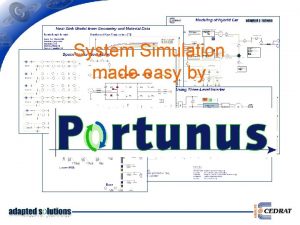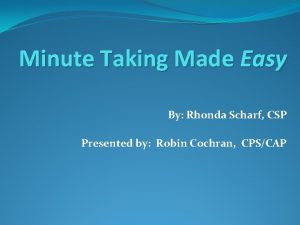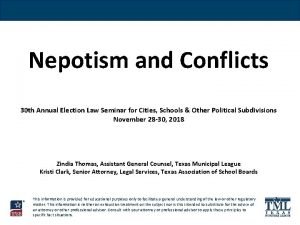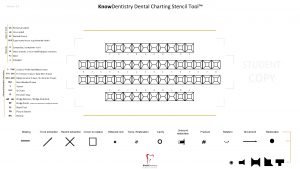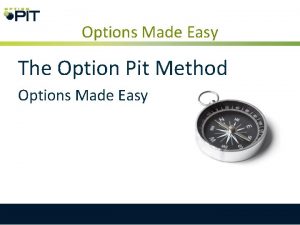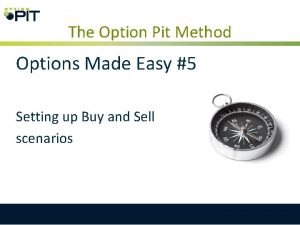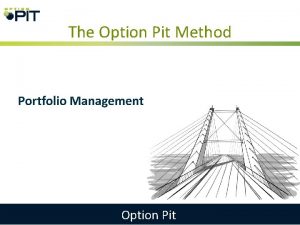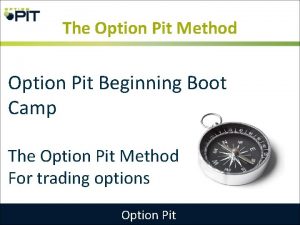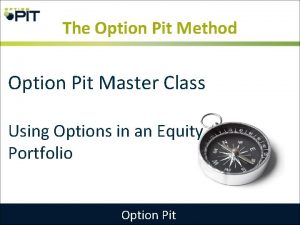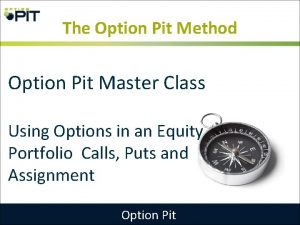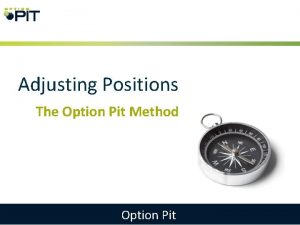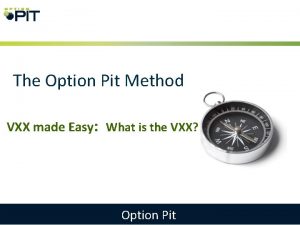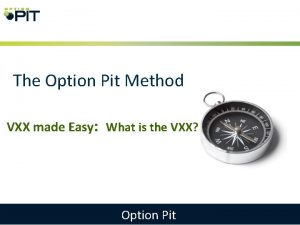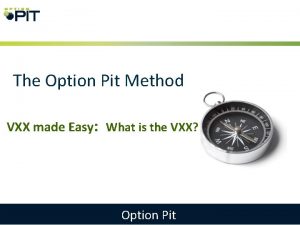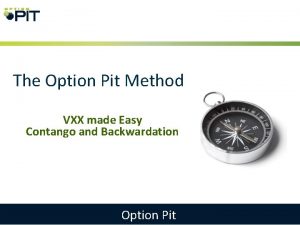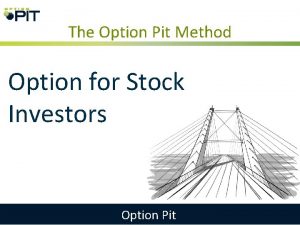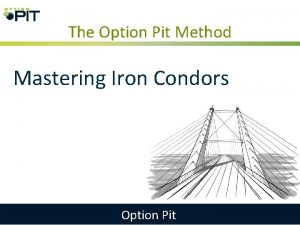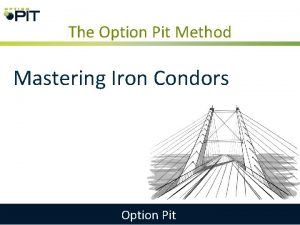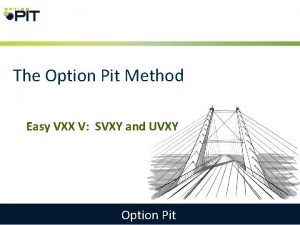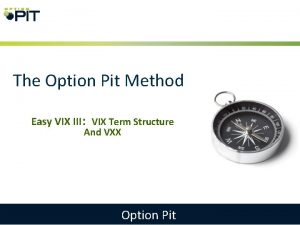The Option Pit Method Options Made Easy 4























- Slides: 23

The Option Pit Method Options Made Easy 4 Option Spreads

Option Pit Disclosure The materials presented from Option Pit LLC are for your informational and educational purposes only. Option Pit LLC nor its employees do not offer investment, legal or tax advice of any kind, and the analysis displayed with various tools does not constitute investment, legal or tax advice and should not be interpreted as such. Using the data and analysis contained in the materials for reasons other than the informational and educational purposes intended is at the user’s own risk. Option Pit LLC is not responsible for any losses that may occur from transactions effected based upon information or analysis contained in the presented materials. Specific trading ideas or strategies discussed in the presentations or materials are entirely illustrative and do not constitute a solicitation of a transaction (or transactions) or a recommendation to execute a particular transaction or implement a particular trading strategy. To the extent that you make use of the concepts with the presentation material, you are solely responsible for the applicable trading or investment decision. Use caution when entering any option transaction and it is recommended you consult with your financial advisor for investment, legal or tax advice relating to options transactions

What you will learn- Course 4 • Why use a spread? – Controlling volatility and margin risk • How does volatility effect a spreads? – Taking a risk out of play • Why a long spread or why a short spread? – Focus on making money • Why use a complex spread? – Take ‘direction’ risk out of play

Directional Check List • What is the Story • What is the Directional Opinion • What is the Speed • What is the Implied Volatility • What is the best strike? • What is the best term to buy • What is the Best Spread? Course 1 Course 2 OR SELL? Course 3 Course 4

NVDA call spreads

NVDA calls

Calls versus Call Spreads

Why trade spreads? • Huge reduction in vega (volatility risk) – Vega risk is a change in p/l for a 1 point move in volatility for the options • Huge reduction in dollars at risk – A spread caps the risk so we focus on return for those dollars at risk – 80% of spreads dollars are at risk overnight

Understanding and Matching Expectations • Spreads by nature have lower expectations – We expect some movement but not a lot since a big move does not change the payout much • The long spread likes a move in the direction but really needs to be close to the money • We buy these for a particular direction with less volatility risk • The short spread does not like a move in the direction and wants to be far out of the money • We sell these spreads for a drop in volatility and direction

Skew

Notes about Skew • Each option has a unique implied volatility for any strike in the cycle • Put skew usually gets more expensive as the strikes drop below the money • Call skew usually gets cheaper as the strikes rise above the money – What this means is that after a point, there is diminishing returns on a spread

Rules for setting up spreads • For long spreads- start at least 1 straddle width from the long side and work out – Look for skew to give some hint on what you give up for the distance we go away from the money • For short spreads – Place the short strike at the edge of the straddle and work out – Look for a 15% return on real risk minimum

Some Tricks to Spread Buying • Put spreads are usually very cheap for the dollar and don’t decay very much – They make great hedges for long calls – Better short term since time kills the short put • Call vertical spreads generally are poor trades since they give up skew and take quite a while to generate dollars – The exception is any time the skew slopes “upward” for the calls – Could be good in “covered call” position mid-term • Let’s we an example of a Tweener

Delta

Deciding what to trade • The decision tree for Making Options Easy starts here: – Either call spreads or put spreads, long or short are mostly about direction (delta) • What we decide on for the spread is “how right” we have to be for the trade – 100% right TO 25% right (look at the delta) » How OTM are we or do we need to be? – Let’s try to optimize with NVDA spreads into earnings.

NVDA

NVDA volatility

Recall-Simple Option Movement • With these simple rules we can set up basic buy and sell decisions over a period of time. – The ATM straddle – this is helpful in estimating the markets best guess for a move TO EXPIRATION – The 1% Rule per day- A 1% move per day equates to a 16% volatility close to close • If you sell a spread, how fast can it get there? – Let’s work that out

Expected Moves

Spreads and Volatility • The higher the implied volatility the more likely we are to look at some kind of spread – Spreads take the real risk from 2 Greeks to 1 • Buying OTM spreads only make sense if there is a longer period of time, say 1 month or so – Time is volatility – For a giant move, buy an option • ITM spreads can take a lot of short term volatility risk out of play

Complex Trades • The trades are not complex, just more than 2 legs – This can be butterflies, condors, protected time spreads, pairs, etc • Multi-leg trades are best when we want less direction and more of a bet on volatility – We change or game from direction of underlying to direction of volatility

In Review • • Spreads are mainly for risk reduction The key spreads really is ITM or OTM Spreads crush volatility risk Complex spreads help reduce delta risk

Thank you for taking tonight’s course! If you like our content and substance get $100 off for our next 2 Saturday classes! • Go to: https: //optionpitmembers. com/events/ And use Promo Code 100 off
 Eh option
Eh option Soal pilihan ganda (multiple choice)
Soal pilihan ganda (multiple choice) Option a option b
Option a option b Inductive vs deductive reasoning
Inductive vs deductive reasoning Inductive vs deductive reasoning
Inductive vs deductive reasoning Every quiz has been easy. therefore the quiz will be easy
Every quiz has been easy. therefore the quiz will be easy Prismoidal correction formula
Prismoidal correction formula Simulation made easy
Simulation made easy Minute taking made easy
Minute taking made easy Coagulation pathway made easy
Coagulation pathway made easy Tasc psychometrics made easy
Tasc psychometrics made easy Texas nepotism law chart
Texas nepotism law chart Evangelism made easy
Evangelism made easy Balancing chemical equations made easy
Balancing chemical equations made easy Significant figures made easy
Significant figures made easy Using the force made easy
Using the force made easy Leed v4 addenda
Leed v4 addenda Dental base charting
Dental base charting Essay made easy
Essay made easy Online meetings made easy
Online meetings made easy Laura acrostic poem
Laura acrostic poem Cosmetics made easy
Cosmetics made easy Communication made easy
Communication made easy Easy agile
Easy agile







